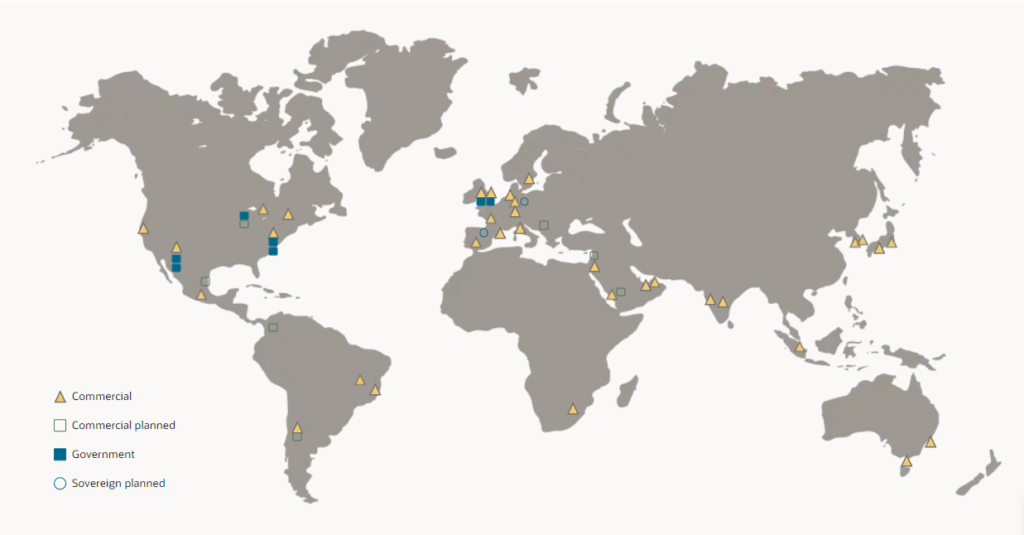Let’s discuss the available regions of Oracle Cloud Infrastructure (OCI). A region refers to a localized geographic area, with an availability domain comprising one or more data centres situated within a region. Essentially, a region is made up of one or more availability domains.
Oracle recently announced having the broadest availability of Cloud Infrastructure with 40 regions available and plans to open nine more in the years to come. The map below shows the currently available regions:

The majority of regions are single availability domains (AD) or data centers, with each AD having three Faulty Domains (FD) providing hardware redundancy. Oracle intends to add multiple ADs in the future, depending on the rising demand in a particular region. Interestingly, Oracle now has two or more regions in a single geography, which helps mitigate application high availability in a single geographical location.
Here is a detailed list of available OCI regions by geography:
| Geography | Country | Region Name | Availability Domain Count |
|---|---|---|---|
| North America | USA | US East (Ashburn) | 3 |
| North America | USA | US West (Phoenix) | 3 |
| North America | USA | US West (San Jose) | 1 |
| North America | Canada | Canada Southeast (Montreal) | 1 |
| North America | Cananda | Canada Southeast (Toronto) | 1 |
| EMEA | UK | UK South (London) | 3 |
| EMEA | UK | UK West (Newport) | 1 |
| EMEA | Germany | Germany Central (Frankurt) | 3 |
| EMEA | Switzerland | Switzerland North (Zurich) | 1 |
| EMEA | Netherlands | Netherlands Northwest (Amsterdam) | 1 |
| EMEA | France | France Central (Paris) | 1 |
| EMEA | France | France South (Marseille) | 1 |
| EMEA | Italy | Italy Northwest (Milan) | 1 |
| EMEA | Sweden | Sweden Central (Stockholm) | 1 |
| EMEA | Spain | Spain Central (Madrid) | 1 |
| EMEA | Saudi Arabia | Saudi Arabia West (Jeddah) | 1 |
| EMEA | UAE | UAE East (Dubai) | 1 |
| EMEA | UAE | UAE Central (Abu Dhabi) | 1 |
| EMEA | Israel | Israel Central (Jerusalem) | 1 |
| EMEA | South Africa | South Africa Central (Johannesburg) | 1 |
| Latin America | Brazil | Brazil East (Sao Paulo) | 1 |
| Latin America | Brazil | Brazil Southeast (Vinhedo) | 1 |
| Latin America | Chile | Chile Central (Santiago) | 1 |
| Latin America | Mexico | Mexico Central (Queretaro) | 1 |
| Asia Pacific | Japan | Japan East (Tokyo) | 1 |
| Asia Pacific | Japan | Japan Central (Osaka) | 1 |
| Asia Pacific | South Korea | South Korea Central (Seoul) | 1 |
| Asia Pacific | South Korea | South Korea North (Chuncheon) | 1 |
| Asia Pacific | Australia | Australia East (Sydney) | 1 |
| Asia Pacific | Australia | Australia Southeast (Melbourne) | 1 |
| Asia Pacific | India | India West (Mumbai) | 1 |
| Asia Pacific | India | India South (Hyderabad) | 1 |
| Asia Pacific | Singapore | Singapore (Singapore) | 1 |
Note that the list above is for the Public Cloud Regions, but Oracle also provides Government Cloud.
| Country | Region Name | Availability Domain Count |
|---|---|---|
| USA | US Gov East (Ashburn) | 1 |
| USA | US Gov West (Phoenix) | 1 |
| USA | US DoD East (Ashburn) | 1 |
| USA | US DoD North (Chicago) | 1 |
| USA | US DoD West (Phoenix) | 1 |
| UK | UK Gov South (London) | 1 |
| UK | UK Gov West (Newport) | 1 |
With its presence in 22 countries, OCI’s availability is truly global. However, Oracle should consider adding multiple ADs in each region to improve the high availability of applications hosted in the cloud. Currently, most regions have only one AD, which could result in a single point of failure for applications hosted in that region.
I hope this post has helped you understand OCI regions and their global footprint. I will continue to update this post as new regions and ADs become available.
I welcome your suggestions and comments to further improve my blog. Thank you for reading.